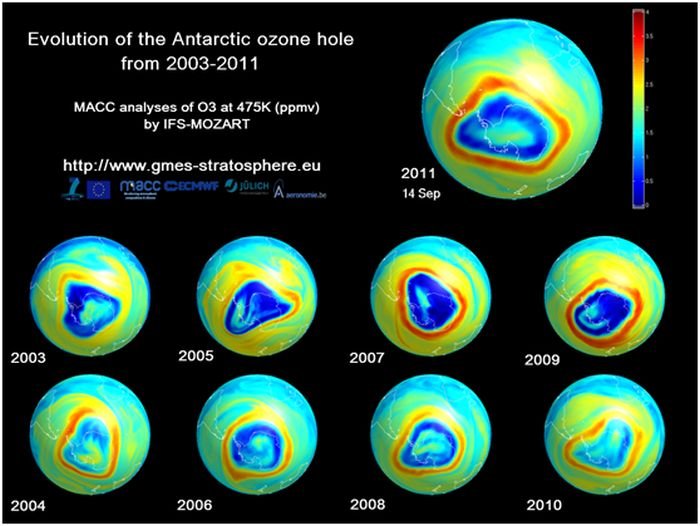Our protector is losing strength | Nuestra protectora está perdiendo fuerzas
The ozone layer
One of the environmental problems we hear the most is the deterioration of the ozone layer. One part is done naturally, but the other part is by human activity.
What is the ozone layer?
It is a natural ozone gas belt that is between 15 and 30 km above the Earth.
This acts as a shield against the harmful ultraviolet B radiation, emitted by the Sun.
It is composed of ozone, a highly reactive molecule that is composed of 3 oxygen atoms.
It is in constant formation and breaks 10-15 km above the earth's crust, in the stratosphere.
What is its role?
As I was saying before, the ozone layer serves to protect living beings from the sun's ultraviolet radiation .
What is the problem?
It is wearing down. Since the twentieth century, scientists have been studying it and have discovered what is known as the hole in the ozone layer, where density decreases very rapidly.
Although most of the polluting emissions occur in the northern hemisphere, the hole is on the southern region of the Antarctic .
This is because in that region the conditions for the formation of a class of clouds in the stratosphere are given.
The hole is mostly produced by chlorofluorocarbons (CFCs) and soil fungicides.
What are CFCs?
They are a family of compounds formed by atoms of Carbon, Fluorine and Chlorine. They are non-toxic and have very low reactivity. They are also refrigerants.
For these reasons they are very useful commercially, in spray, foams, insulators ... During the decade of the 80's, more than one million tons were expelled per year, without knowing or considering what could happen.
The direct relationship between CFC emissions and the ozone hole was later observed. This is because the low reactivity of CFCs allows them to reach the stratosphere unaltered. Once there the UV photolyze them, releasing chlorine radicals. These radicals intervene in chemical reactions that cause the destruction of ozone molecules and therefore the thickness of the ozone layer.
A single chlorine radical can destroy 50,000 ozone molecules .
International agreements were signed to limit the emissions of these compounds. All production was finished in 1995.
Despite the elimination of CFCs, the hole has not disappeared but it has decreased.
_
La capa de ozono
Uno de los problemas ambientales que más escuchamos es el deterioro de la capa de ozono. Una parte se realiza de forma natural, pero la otra, es por la actividad humana.
¿Qué es la capa de ozono?
Es un cinturón de gas ozono natural que se sitúa entre los 15 y 30 km sobre la Tierra.
Ésta actúa como un escudo contra la dañina radiación ultravioleta B, emitida por el Sol.
Está compuesta por ozono, una molécula altamente reactiva que está compuesta por 3 átomos de oxígeno.
Está en constante formación y se rompe a 10-15 km sobre la corteza terrestre, en la estratosfera.
¿Cuál es su función?
Como iba diciendo antes, la capa de ozono sirve para proteger a los seres vivos de la radiación ultravioleta del Sol.
¿Cuál es el problema?
Se está desgastando. Desde el siglo XX, los científicos se han dedicado a estudiarla y han descubierto lo que se conoce como el agujero en la capa de ozono, donde la densidad se reduce muy rápidamente.
Aunque la mayor parte de las emisiones contaminantes se produzcan en el hemisferio norte, el agujero se encuentra sobre la región sur de la Antártida.
Esto se debe a que en esa región se dan las condiciones para la formación de una clase de nubes en la estratosfera.
El agujero se produce en su mayoría por los clorofluorocarbonos (CFCs) y los fungicidas del suelo.
¿Qué son los CFCs?
Son una familia de compuestos formados por átomos de Carbono, Flúor y Cloro. No son tóxicos y tienen una reactividad muy baja. Además son refrigerantes.
Por estas razones son muy útiles comercialmente, en spray, espumas, aislantes... Durante la década de los 80 se expulsaron más de un millón de toneladas por año, sin saber ni considerar lo que podía pasar.
Más tarde se observó la relación directa entre las emisiones de CFCs y el agujero de la capa de ozono. Esto se debe a que la baja reactividad de los CFCs, permite que lleguen inalterados a la estratosfera. Una vez allí los UV los fotolizan, liberando radicales de cloro. Estos radicales intervienen en unas reacciones químicas que originan la destrucción de las moléculas de ozono y por lo tanto el grosor de la capa de ozono.
Un solo radical de cloro puede destruir 50.000 moléculas de ozono.
Se firmaron acuerdos internacionales para limitar las emisiones de estos compuestos. Toda la producción se acabó en 1995.
A pesar de la eliminación de los CFCs, el agujero no ha desaparecido pero sí ha disminuido.

Sources|Fuentes:
https://cambioclimaticoglobal.com/
https://www.nationalgeographic.es/
https://es.wikipedia.org/wiki/CFC
https://es.wikipedia.org/wiki/Capa_de_ozono
App: Adobe Photoshop Express
Make with|Realizada con: Cámara | Camera :Lumix 5X optical zoom
Do not plagiarize | use the photo|No plagiar/usar la foto
More about me | Más sobre mí:
https://steemit.com/@rafabr || https://deals.weku.io/@ralu
¡Tengan un buen día!
Have a great day!
